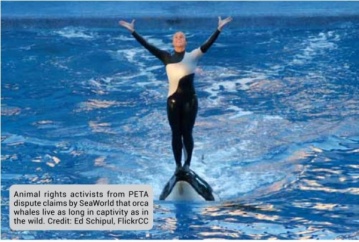
I’ve been seeing this ad on TV a lot by SeaWorld claiming they don’t take orcas from the wild and that orcas live just as long in captivity as they do in the wild. Are these claims true?
SeaWorld has faced criticism and plummeting profits after the release of the 2013 documentary, Blackfish, which tells the story of Tilikum, a performing killer whale that killed several people while in captivity. Although wild capture was outlawed in the U.S. in 1972, killer whales continued to be seized in foreign waters: Tilikum was caught, aged two, off Iceland in 1983. Today, SeaWorld asserts that its population of killer whales has been successfully producing healthy offspring since 1985, and the success of this program has made it possible for them to care for and display killer whales to the public without collecting a killer whale from the wild in 35 years.
For its part, SeaWorld disputes the negative accusations. Earlier this summer, SeaWorld San Diego released a study contrasting current published data for survival and reproductive activity of known-age Pacific Northwest killer whales since 1975 with the life history of killer whales in SeaWorld’s care. The study concluded the average life expectancy for SeaWorld’s killer whales is 41.6 years; average life expectancies for Southern and Northern Resident killer whales are 29.0 and 42.3 years, respectively.
“Our animals are living as long as wild populations,” says Dr. Todd Robeck, Vice President of Theriogeneology at SeaWorld and the primary author of the study. “The data shows without a doubt that our animals live as long as the ones in the wild.” Additionally, the study indicates that average calf survival rate to age two in the Southern Resident killer whale population is 79.9 percent - less than SeaWorld’s 96.6 percent average.
“Although emotion will always be a part of the debate as to whether killer whales, or any other species, should be maintained in human care, it is absolutely necessary to have validated facts when an argument for or against is being made on scientific grounds,” says study author Kevin Willis, Vice President for Biological Programs for the Minnesota Zoo. “Based on the available data, it is now clear that it cannot be truthfully argued that killer whales should not be maintained in captivity because they have a shortened life expectancy relative to their wild counterparts,” Willis adds.
Animal rights groups have been quick to criticize SeaWorld’s study. People for the Ethical Treatment of Animals (PETA) points out that another study published in April 2015 in the journal Marine Mammal Science found that the median life expectancy of 83 killer whales kept in captivity from 1961-2014 in the U.S. was only 12 years. The study also determined that 118 killer whales kept in facilities outside the U.S. during those same years were found to have a median lifespan of just four years.
"Contrary to what the authors of this study - three of whom are SeaWorld employees, while the fourth works for a zoo - would have people believe, the average age of the orcas who have died at SeaWorld is 13 years, and only one orca at SeaWorld - Corky, who was captured in the wild -has actually reached SeaWorld´s claimed ‘average life expectancy’ of 41.6 years,” reports Jared Goodman, PETA’s director of animal law. “Every single orca who has perished at SeaWorld died far short of how long they are expected to live, though it is in fact hard to call it ‘living’ when their ‘life’ consists of being forced to perform circus-style tricks in a tiny concrete tank. SeaWorld´s claims simply don’t hold water.”
CONTACT: SeaWorld, www.seaworld.com; Blackfish, www.blackfishmovie.com; PETA, www.peta.org.
EarthTalk® is produced by Doug Moss & Roddy Scheer and is a registered trademark of Earth Action Network Inc. View past columns at: www.earthtalk.org. Or e-mail us your question: earthtalk@emagazine.com.
